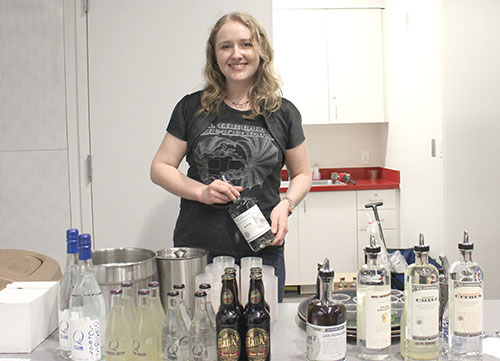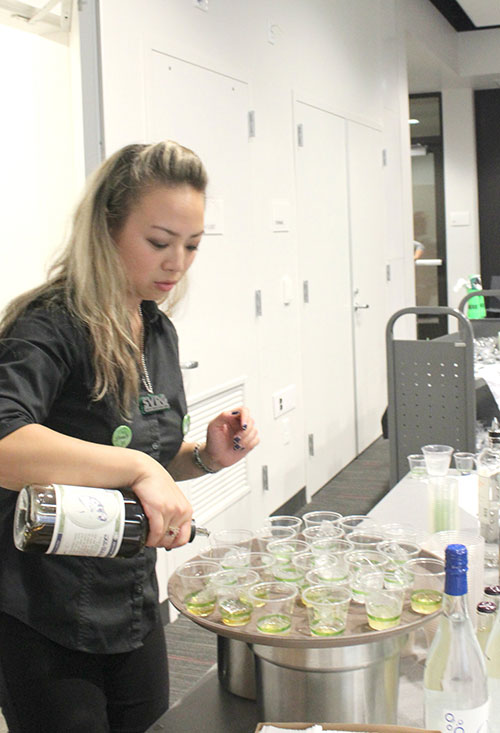

“Back in the day before we had all this refrigeration stuff…humans developed ways of preserving amazing fruit,” says Samantha Shireman, tasting room assistant manager of St. George Spirits. “You had this one harvest of the year, and you could either make jam or you could make booze. If you want to make jam, you came to the wrong event.”
The event was Shireman’s Oct. 6 Northside Library lecture on liquor and the many offerings at St. George Spirits, an Alameda-based distillery. Eighty visitors, bearing their IDs, enjoyed free liquor tastings and $5 cocktails. The Silicon Valley Roller Girls, a non-profit organization, made about $700 from cocktail and merchandise sales. All the drinks were donated by St. George Spirits.
“It’s always great when you can learn something and learn about it not with someone just talking at you, but while being hands on with your learning,” says Angela Ocana, librarian.
During the lecture, attendees’ hands were on small plastic cups containing liquor samples; these included a heat-spreading pear brandy; a rum that tasted like an earthy martini; a citrus vodka made with Seville marmalade oranges; a green chile vodka with jalapeno, cilantro, and lime notes; and a minty absinthe served with a chunk of ice.
Sumit Chawla revealed his favorite spirit from the tasting.
“I like the absinthe because it had a strong character,” he says. “I am a fan of single malts and the absinthe was the closest to that.”
Speaking of absinthe, Shireman shared some enlightening history on how this spirit became illegal in parts of Europe and the United States. According to her, the popularity of absinthe occurred during the mid-1800s in Paris among artists and bohemians after American aphids demolished French vineyards, causing the price of wine to skyrocket. So drinkers turned to absinthe, the cheaper alternative.
“We’re dealing with suddenly a huge demand and a complete lack of regulations,” Shireman says. “We get distilleries cutting important corners, like dying the drink a bright shiny green using copper sulfate, which is very toxic, using lead in some of the bottling components, padding things out with wood alcohol, which often has a high methanol content, and churning out some bitter, nasty tasting absinthe.”
Shireman explains that authentic absinthe must contain some sort of anise, fennel, and grand wormwood. Unfortunately, wormwood is considered terribly bitter.
“So this is where you start seeing that lovely ritual- if any of you have seen Moulin Rouge; you have that sugar cube and that slotted spoon and you drip water through the sugar cube which is going to dissolve your sugar, drip into the absinthe and sweeten your terrible absinthe and make it more palatable,” Shireman says. “There’s nothing wrong with adding sugar to your absinthe… [until some smarty pants began taking] that little sugar cube and lighting it on fire, and then take a big breath in… The sugar cube was often doused in laudanum, which is an opium tincture. Poets and artists used to wine suddenly were drinking alcohol that was going to 60 to 70 percent plus alcohol by volume. So we’re getting some alcohol poisoning, copper sulfate poisoning, potentially lead poisoning, methanol poisoning, and we’re free- basing opium at the same time. We have some happy poets and artists, though we have a few people who are dying young. Meanwhile the wine industry was really working hard to get back on its feet…. It ran this campaign convincing a lot of people that wine was natural…[while also saying] that wormwood makes you hallucinate and absinthe will make you go crazy. [It was] a very successful campaign.”





